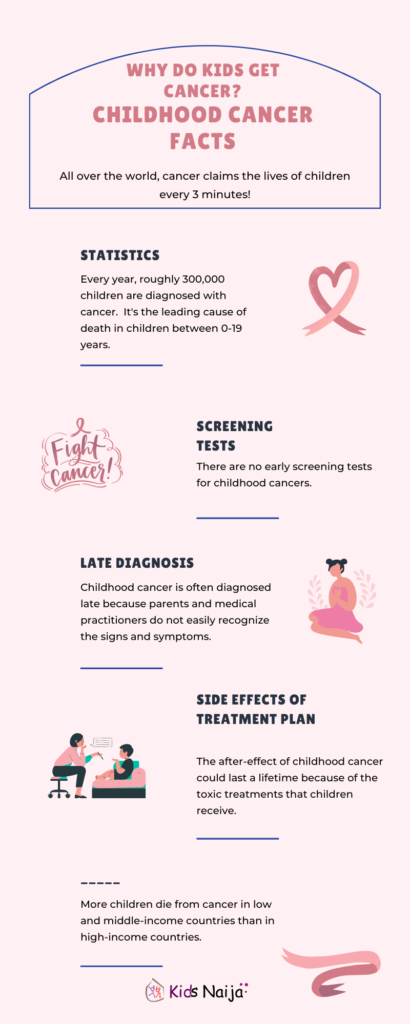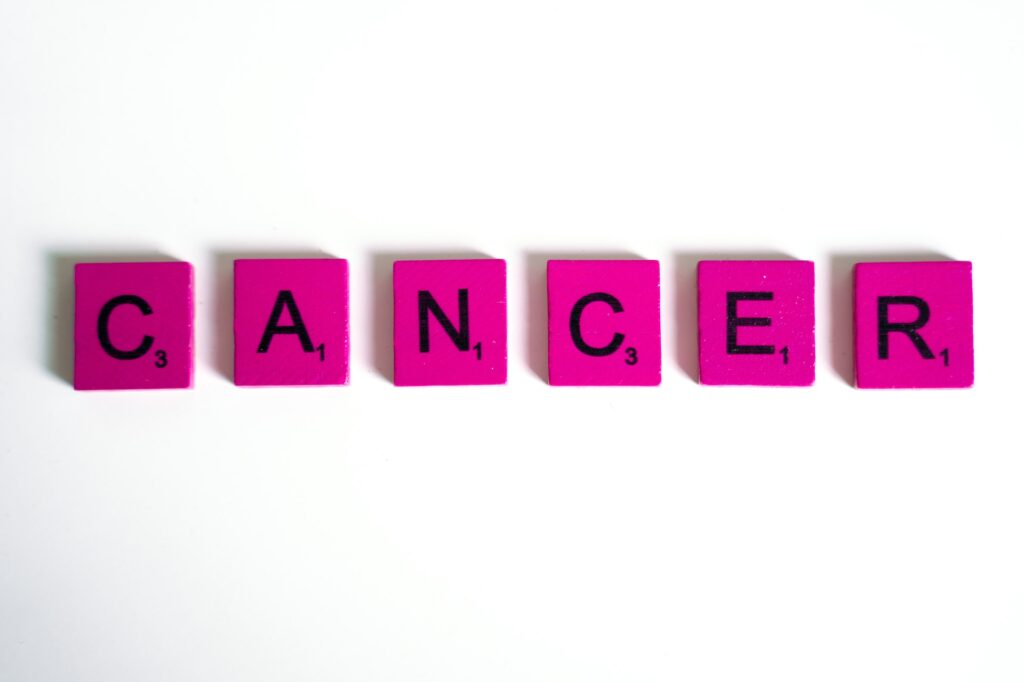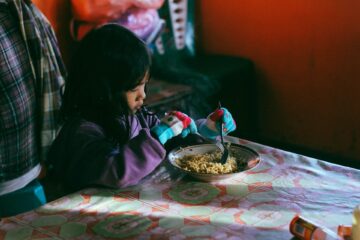Why do kids get cancer?
Did you know that cancer is a leading cause of death in children between 0-19 years?
Every year, roughly 300,000 children are diagnosed with cancer. Yet, only 20% of these children get cured in low and middle-income countries.
For low-income countries like Nigeria, certain factors hinder the diagnosis and treatment of childhood cancer. They include:
- Issues of poor infrastructure
- Inadequate medical personnel
- Inadequate funding of the health sector
- High level of ignorance about childhood cancers
- Seeking an alternative source of treatment
The big question is: why do kids get cancer? Before we answer this question, let’s look at the most common childhood cancers.
Sneak peek…
Common Types of Childhood Cancer
- Leukaemia: This cancer affects blood-forming organs in children. It causes the bone marrow and other blood-forming organs to proliferate into many undeveloped and abnormal blood cells.
- Brain Cancer: Here, brain cells grow abnormally and become cancerous. These cancerous cells then kill the healthy brain cells.
- Lymphomas: This is a cancer of the lymphatic system. The system that helps remove toxins and unwanted materials from the body.
- Wilms’ Tumour: This is a type of kidney cancer that occurs in children between age 3 and 4, mostly, among the female gender. The risk of developing Wilms’ tumour reduces at age 5. It is also known as Nephroblastoma.
- Neuroblastoma: This cancer develops in immature nerve tissues. It is common among children below age 5.
Childhood Cancer Facts

- All over the world, cancer claims the lives of children every 3 minutes!
- Childhood cancer is often diagnosed late because parents and medical practitioners do not fully understand the signs.
- There are no early screening tests for childhood cancers.
- The after-effect of childhood cancer could last a lifetime because of the toxic treatments that children receive.
- Some children die from toxic cancer treatments.
- More children die from cancer in low and middle-income countries than in high-income countries.
What are the early signs of childhood cancer?

- Frequent headaches
- Unexplained fever
- A sudden lump in the stomach
- Persistent weight loss
- Easily bruising and bleeding
- Dizziness
- Problems with vision
- Body aches
- Diarrhoea
- Fatigue
These childhood cancer signs cover the five most common childhood cancers.
The reason why kids get cancer is not fully understood, but the risk factors are well known.
Why Do Kids Get Cancer? Risk Factors Associated with Childhood Cancer
Lifestyle and environmental risk factors like tobacco smoking, obesity, unhealthy diet, inadequate physical activities, pollutants etc., take time before influencing carcinogenesis. Hence, very few of them are risk factors of childhood cancer.
Notwithstanding, several other factors increases or reduces the risk of childhood cancer. They include:
- Genetic Abnormalities: Cancer is majorly a genetic disease. It stems from chromosomal changes in the DNA that leads to the formation of an abnormal protein. This interferes with normal cellular activities leading to the development and proliferation of abnormal cells in the body.
- Exposure to Radiation: Exposing children to ionizing radiation could trigger DNA changes that bring about cancer formation.
- Chronic Infections: Human papillomavirus (HPV), HIV, malaria and some other chronic infections are known to initiate carcinogenesis in children, especially those in low and middle-income countries.
- Prior chemotherapy: Children who’ve had cancers before and were treated using chemotherapy are at an increased risk of developing second cancer in the future. See more on the effects of cancer here.
- Birth Weight: A study proves that a child’s risk of developing lymphoid leukaemia and Wilms’ tumour increases with a birth weight greater than 4 kg. The same happens in babies that are large for their gestational age.
- Congenital Anomalies: Research proves that congenital anomalies like Neurofibromatosis, Bloom syndrome, especially Down syndrome, increase a child’s risk of developing leukaemia and other cancer.
- Maternal Age: Children of older mothers are at a higher risk of developing leukaemia, Wilms’ tumour, neuroblastoma, lymphoma, nervous system tumours and soft tissue tumours.
Can Babies Get Cancer In The Womb?
Unfortunately, yes. The first known case was in Japan, the leukaemia cells were transmitted from the mother to the foetus. However, this is a rare occurrence.
In this case, the cancer cells lacked a unique signature – possessed by all cells – that prevented the child’s immune system from identifying it as an intruder and so, it failed to destroy it.
This discovery helped scientists to know that the immune system can destroy leukaemia cells.
Why Are Children Born with Cancer?
Children are rarely born with cancer. However, for children born with cancer, Mel Greaves, a cancer Biologist, explains that the mutation might have happened in utero. That is, during pregnancy.
However, in most cases, even if cancer develops in the womb, it does not appear until infanthood.
Helping Your Child Overcome Cancer
Getting through cancer is a devastating ordeal, and it’s even more so in young children who ought to be in school or jumping around at home with their toys.
For this reason, your child needs your care and attention to overcome this disease and the baggage that accompanies.
How you can help:
- You can help your children overcome cancer by making them understand what they’re going through without creating fear in their hearts.
- Make sure they do not miss their hospital appointments or forget their medications.
- Help them maintain a healthy diet and lifestyle.
- Because of how horrifying the cancer experience could be, ensure that you keep them from things that could trigger the memory.
- Children are dreamers – even cancer can’t take that away from them; encourage your child’s dreams. If it’s possible, help them fulfil it.
- Because children look up to their parents for everything, you need to show strength and courage so that they can tap from it.
- You need to be physically, mentally, and emotionally fit to help the child – take care of yourself, too.
Final note
Scientists are putting efforts into reducing the growing rate of childhood cancer all over the world.
To increase the rate of early diagnosis, the symptoms of childhood cancers are being reviewed/assessed. Drugs are also being approved to reverse the harmful effect of cancer treatment.
To win this fight, parents would have to play their part in monitoring their children, especially those at risk of childhood cancer, for signs and symptoms and reporting any anomaly to their doctor.
If you have more questions on childhood cancer, see this FAQs list!


